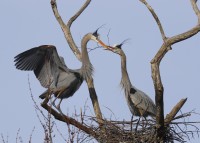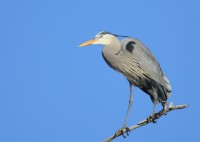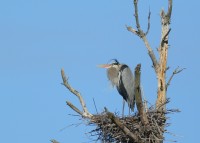Great Blue Herons nest building
April 3, 2017 in Nearby Waterbirds
 Great Blue Herons begin returning to former breeding colonies to breed in February and March. Nest building begins in March or April. Three to five pale, greenish-blue eggs are incubated for 25-29 days by both sexes. Young first fly at around 60 days of age and leave the nest at 65-90 days, at which time they are similar in size to adults. Great Blue Herons have one brood (clutch) per year, however, they may renest if their first clutch fails early in the season.
Great Blue Herons begin returning to former breeding colonies to breed in February and March. Nest building begins in March or April. Three to five pale, greenish-blue eggs are incubated for 25-29 days by both sexes. Young first fly at around 60 days of age and leave the nest at 65-90 days, at which time they are similar in size to adults. Great Blue Herons have one brood (clutch) per year, however, they may renest if their first clutch fails early in the season.



